One of the most cherished experiences for any dog owner is a peaceful walk with their furry companion. Yet, this simple joy often turns into a frustrating tug-of-war, with dogs pulling their humans down the street like determined sled dogs. If you dream of leisurely strolls instead of a constant battle, it’s time to learn How To Train A Dog To Walk Nicely through effective loose leash walking techniques.
It’s common for dogs to struggle with not pulling on the leash; they aren’t born with an innate understanding of polite walking manners. Teaching loose leash walking is one of the most frequent requests I receive from frustrated dog owners, and I completely empathize – being pulled relentlessly is incredibly disheartening.
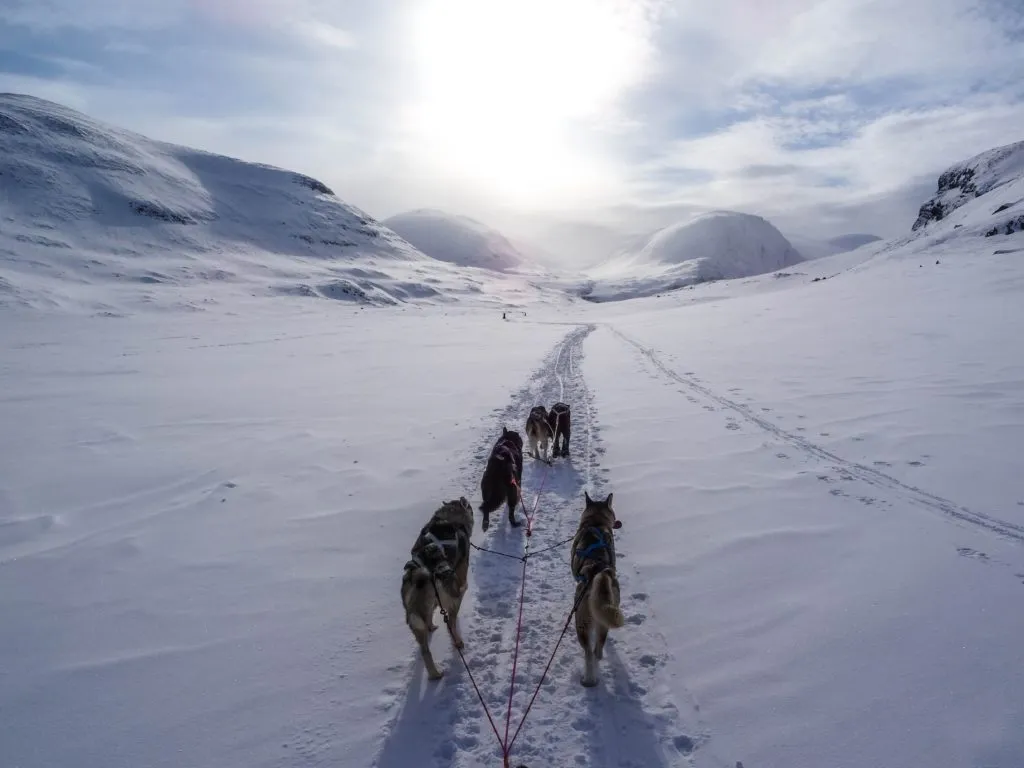 A team of energetic sled dogs straining against their harnesses and leashes, highlighting the common challenge of dogs pulling on leash.
A team of energetic sled dogs straining against their harnesses and leashes, highlighting the common challenge of dogs pulling on leash.
Walking your dog should be an enjoyable bonding experience, but that’s impossible when you’re being dragged along. Through years of experience, I’ve successfully taught countless dogs to achieve loose leash walking, even those who initially pulled with all their might. I can confidently assure you that with patience and the right approach, every dog can become a delightful walking partner. Even better, you can teach your dog not to pull using solely positive reinforcement methods. I strongly advocate against aversive tools like choke chains, shock collars, or prong collars. If you wouldn’t use something on a child, it shouldn’t be used on your dog.
There’s a widespread misconception that a dog pulling on the leash is an act of dominance or an attempt to control you. This is simply not true. Leash pulling merely indicates that your dog hasn’t been taught appropriate boundaries and is currently more captivated by the environment than by you. This behavior is normal and natural for dogs. It’s our responsibility as owners to clearly communicate our expectations for polite walking.
Unfortunately, these incorrect beliefs often lead owners to perceive their dogs as “bad” when they pull, resulting in a lack of patience and the use of punishment-based training methods. While some trainers suggest techniques ranging from mildly aversive to outright abusive, as a positive trainer, I reject them all. My extensive experience shows that you can absolutely get your dog to stop pulling you and walk nicely using only positive, reward-based training.
This article is intentionally thorough. I often found other guides on loose leash walking to be too simplistic, offering “5 quick steps” that didn’t provide enough depth for dog owners to truly implement. My goal here is to offer a comprehensive, actionable guide covering everything you need to know about how to train a dog to walk nicely and prevent leash pulling. A pleasant walk is one of the best ways to bond with your dog, and I want every owner to enjoy this experience!
I highly recommend reading this article in its entirety to ensure you grasp all the interconnected strategies for solving your dog’s pulling habits.
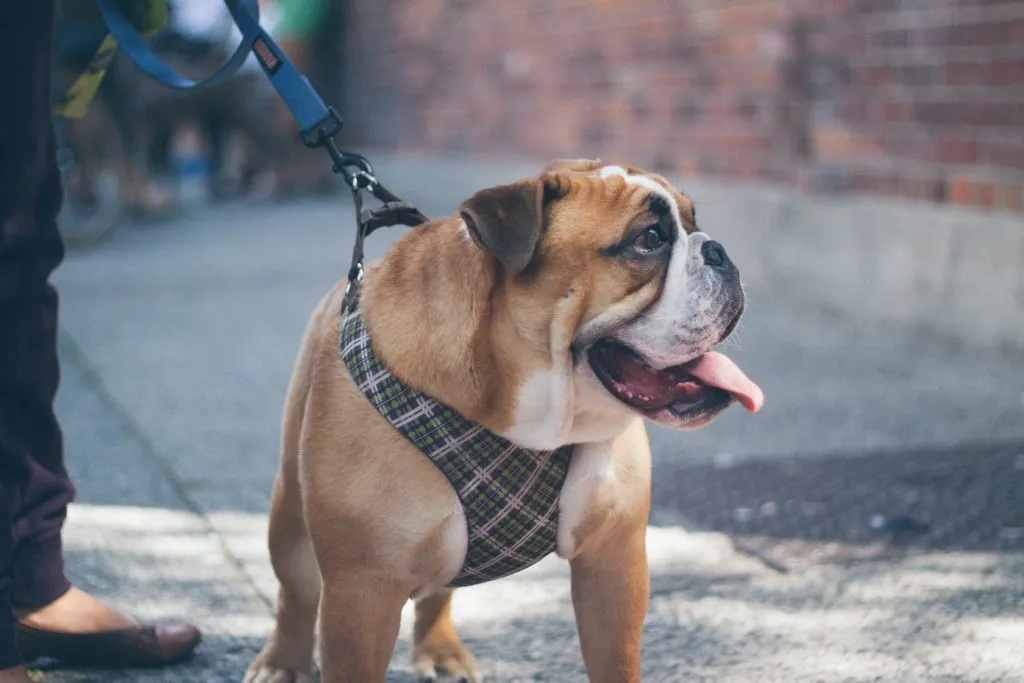 A strong bulldog pulling hard on its leash, demonstrating the struggle many dog owners face during walks and the need for loose leash training.
A strong bulldog pulling hard on its leash, demonstrating the struggle many dog owners face during walks and the need for loose leash training.
Why Does My Dog Pull on Leash? Debunking Myths
Contrary to popular belief, your dog’s leash pulling behavior has nothing to do with dominance, control, or them “being a jerk.” The real reasons are much more straightforward and rooted in their natural instincts and needs:
1. Not Enough Exercise
Many dogs, especially certain breeds, do not receive sufficient exercise for their energy levels. For some, a 30-minute walk is their only opportunity for physical activity, which is often far from enough. It’s unreasonable to expect a dog with pent-up energy to calmly walk beside you.
For successful loose leash training, ensure your dog is adequately tired before your training sessions. This could involve off-leash running, playing fetch with a ball or frisbee, or a trip to a dog park. If your schedule doesn’t allow for this, consider hiring a dog walker or enrolling them in doggy daycare. Providing proper exercise is a fundamental part of responsible dog ownership. Research your dog’s breed-specific needs to meet them fully before expecting specific behaviors from your dog.
2. Humans Are Slow
Most dogs naturally walk at a faster pace than humans. Imagine trying to walk a turtle on a leash; eventually, you’d likely get bored and want to move faster. To dogs, we are the turtles. It’s important to recognize that slowing down their natural pace is incredibly difficult and unnatural for them. While it requires significant effort on their part, they absolutely can learn to adjust their pace.
3. Outside Smells Amazing
Consider this: you’re with a friend, and your phone buzzes. Even if you know it’s impolite, you’re probably tempted to check it, right? Or imagine trying to work at your desk while your favorite TV show plays nearby; distraction is almost inevitable.
For dogs, the sights and, most importantly, the smells of the outdoors are equally, if not more, distracting during the “job” of walking politely. Dogs possess an average of 50 times more scent receptors and 40 times more brain space dedicated to processing smells than humans. We can’t even begin to comprehend it, but dogs can detect scents diluted to 1-2 parts per trillion. What appears to you as a simple patch of grass is, to a dog, an incredible world of olfactory bliss.
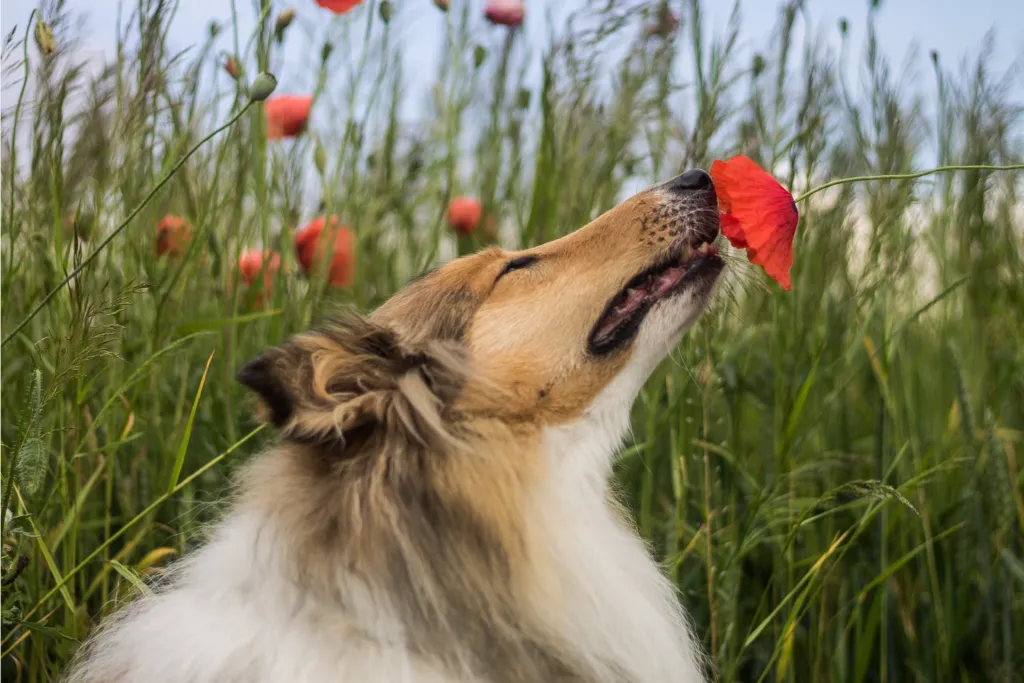 A dog deeply sniffing a patch of grass, illustrating how external smells are a major distraction and reward for dogs during walks, leading to leash pulling.
A dog deeply sniffing a patch of grass, illustrating how external smells are a major distraction and reward for dogs during walks, leading to leash pulling.
This incredible sense of smell also means that sniffing can be a powerful reward for dogs. If your dog has been successfully pulling you towards exciting smells for months or years, they have been consistently rewarded for that pulling behavior. Changing this habit will require time, patience, and new, more desirable rewards.
Understanding How Dogs Learn: The Power of Positive Reinforcement
To effectively train your dog from pulling and achieve excellent leash manners, it’s crucial to understand the fundamentals of canine learning. In essence, there are two primary approaches to dog training:
- Reward desired behaviors: This involves reinforcing actions you want your dog to repeat, such as offering a treat when they walk nicely by your side or make eye contact.
- Punish unwanted behaviors: This method seeks to stop behaviors you don’t want, for instance, using a prong collar when a dog pulls.
As a positive reinforcement trainer, I firmly believe it’s our responsibility to clearly teach our dogs what we want them to do. I strongly object to training methods that rely on punishing a dog until they, by trial and error, guess the desired behavior. Imagine if your parents or boss expected you to learn this way; the stress and frustration would be immense. It’s only fair that we explicitly show our dogs what we expect.
Punishment-based techniques emphasize what not to do, while positive training teaches dogs what to do.
When you’re teaching your dog not to pull on the leash, you must start in an environment where they can succeed. Why? Because you need ample opportunities to reward them for getting it right! For many dogs, this means beginning loose leash training inside your home, where distractions are minimal.
It can be challenging to grasp just how much the training environment impacts your dog’s ability to perform. Let’s use an analogy:
Do you know your ABCs? Of course, you do. If I asked you to recite them in your head right now, you’d likely do so effortlessly. This is equivalent to asking your dog to heel indoors—minimal distraction.
Now, what if I asked you to tell your spouse or child the ABCs? A little awkward, perhaps, but certainly manageable. This mirrors asking your dog to heel in your backyard; they’re comfortable, but there’s a touch more distraction.
Finally, imagine being placed on a stage in front of 10,000 people and asked to sing your ABCs into a microphone. You’d likely be so overwhelmed that you might forget how to speak, let alone sing! This is comparable to asking your dog to walk nicely in a highly distracting environment.
How stressed would you feel if you were threatened with punishment for not singing your ABCs perfectly in that high-pressure scenario? This is the equivalent of punishing your dog for not being able to “perform” in a situation you haven’t prepared them for. It’s neither fair nor an effective way to train.
Do not punish your dog for having an emotional response or becoming overwhelmed in a more challenging setting! Furthermore, it’s not effective positive training to put your dog in a situation where they’re too overwhelmed to learn and then attempt to control them solely with a treat.
To utilize positive reinforcement successfully, you must start in an environment where your dog can be successful. Create opportunities for praise and rewards so they can learn your expectations without undue stress. Your ability to say the ABCs is constant, but the context of where you’re asked to say them dramatically changes your chance of success. Dogs are no different. Build up the difficulty gradually, giving your dog ample opportunity to solidify their skills. They absolutely can learn to walk politely in highly distracting environments, but this will not happen overnight. For more detailed insights into canine learning, you can explore resources on [how to stop a dog from pulling on its leash](https://dogcarestory.com/how-to-stop-a-dog-from-pulling-on-its-leash/).
Essential Pre-Leash Walking Skills: Building a Strong Foundation
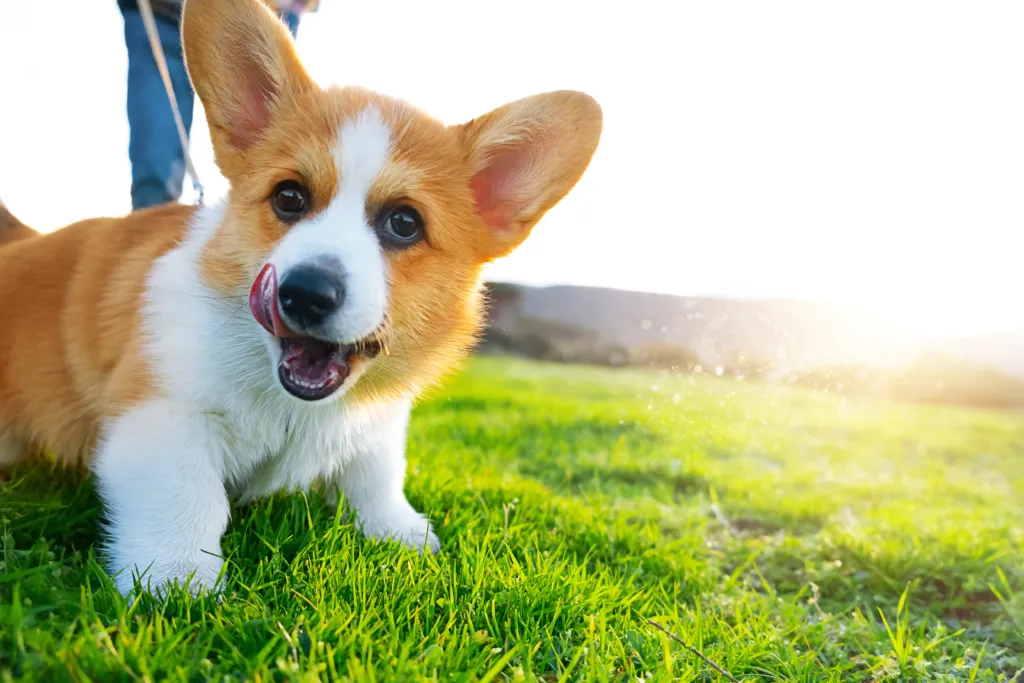 A dog looking attentively at its owner during a training session, emphasizing the importance of focus and foundational skills before teaching loose leash walking.
A dog looking attentively at its owner during a training session, emphasizing the importance of focus and foundational skills before teaching loose leash walking.
Warning: Do not skip these foundational skills and jump directly into loose leash training! Mastering these will build your dog’s impulse control and teach them the immense value of focusing on you. When you eventually begin loose leash walking in more distracting environments, these skills will be invaluable for maintaining your dog’s focus. (Hint: A focused, engaged dog is far less likely to pull!) Invest time in these to save yourself frustration and sore arms.
I’ve included a brief description of why each skill is necessary below. I recommend practicing these for at least a few days before starting any loose leash walking training. Get your dog solid on them!
Sit: The Foundation of Control
The “Sit” command is a basic obedience skill every dog should know. It’s incredibly helpful when teaching loose leash walking, serving as a natural transition between heel commands or as a momentary “time-out” break in distracting settings. It helps your dog pause, collect themselves, and re-engage with you.
Focus: Building Engagement and Communication
Every dog should learn the “Focus” command. Teaching a dog to check in with you is a crucial building block for all advanced obedience skills and strengthens your overall bond. “Focus” teaches your dog that wonderful things happen when they look at you, reinforcing the importance of eye contact for clear communication. In distracting environments, a well-trained “Focus” command can help calm your dog and redirect their attention back to you, a vital component in how to teach your dog to not pull.
Leave It: A Critical Safety Command
“Leave it” is an indispensable skill. While exceptionally useful during distraction training, such as loose leash walking, it can also be a life-saving command. Puppies and dogs are notorious for attempting to gobble up random objects they find on the ground. A solid “Leave it” command can prevent your dog from ingesting something dangerous without you needing to physically intervene. This command serves as a promise to your dog: if they disengage from something they’re interested in, you will reward them with something even better. This skill is paramount in training your dog to ignore tempting distractions and prevent pulling on its leash.
Heeling vs. Loose Leash Walking: Defining Your Goals
The term “loose leash walking” can be interpreted differently by various trainers and owners. In my experience, there are two distinct modes of walking a dog: a perfect heel or a loose leash walk. I personally advocate for and encourage the use of both!
What is Heeling?
To me, “heeling” means the dog walks precisely at your side, without falling behind or advancing beyond your knee. I train dogs to walk on my left side, which is my personal preference. My expectations and boundaries for heeling are significantly stricter than for loose leash walking. I expect the dog to be exactly at my left side, matching my pace. During a heel, I do not permit sniffing breaks or greetings with other dogs.
If this sounds incredibly strict, you’re right; it definitely is. However, teaching your dog to heel is an excellent way to establish clear boundaries and expectations during the learning phase. It has very explicit rules, which dogs often grasp quickly. When you’re first teaching your dog not to pull on leash, I suggest incorporating “heel” about 50% of the time. It communicates unequivocal rules and boundaries. Once a dog is fully trained, I recommend maintaining a strict heel approximately 10% of the time or less. It’s a valuable skill for navigating busy sidewalks or other highly distracting environments where precise behavior is necessary. While too restrictive for full-time use, it’s a crucial skill to learn and maintain.
(Video: Dog Heeling Demonstration)
Here’s a video of a dog I trained named Kiki. She pulled so severely that her owners worried about walking her in winter! It took only about a week to get her to heel as you see in this video. Positive training works!
However, I also believe that walks should be enjoyable for the dog! As your dog becomes more proficient, you should increase the amount of time they spend in a loose leash walk rather than a perfect heel. Loose leash walking allows them the freedom to sniff and simply be a dog! Remember, the walk should be as much for your dog’s enjoyment as it is for yours.
What is Loose Leash Walking?
Once a dog has mastered heeling, I recommend transitioning to loose leash walking for the majority of your time together. I suggest using a 6-foot leash for walks. This length provides enough freedom for your dog to explore and sniff. Let them be a dog! However, I strongly advise against retractable leashes.
So, what exactly is loose leash walking?
I define loose leash walking as my dog’s ability to go anywhere they desire within the 6-foot boundary of the leash. Crucially, there should be no pressure or pulling on the leash. Otherwise, they are free to roam. If my dog wants to sniff something and does so politely (without pulling), I stop and allow it! Sniffing is a healthy and normal activity for dogs. However, if a sniff lasts too long and I wish to continue walking, I expect the dog to join me with just a verbal cue, without any leash tension from either of us. For more insights on this, you can learn [how to get your dog to stop pulling you](https://dogcarestory.com/how-to-get-your-dog-to-stop-pulling-you/).
(Video: Dog Loose Leash Walking Demonstration)
Watch Kiki loose leash walk in this video. I allow her to sniff something she’s interested in, then with no leash tension, I cue her to walk with me again.
Step-by-Step: Training Your Dog to Heel and Loose Leash Walk
Training your dog to walk nicely whether in a heel or with a loose leash requires patience, but the rewards are immense. My dog, Neirah, accompanies me everywhere. She walks so beautifully that I rarely have to think about managing the leash. The ability to get lost in your thoughts and truly relax during walks is a wonderful feeling, and I sincerely want that for you. I’m confident you can achieve it, just as I’ve helped countless other dog owners teach their dog to stop pulling on the leash.
Every dog possesses the ability to walk politely on a leash; they simply need the time and guidance to learn. Your goal is to build a positive association: wonderful things happen when your dog is close to you and paying attention during walks. We achieve this conditioning using high-value treats. Eventually, treats can be phased out (or significantly reduced), and your dog will continue to walk nicely out of habit and desire to engage with you. I rarely carry treats on walks with my dog anymore, yet she consistently chooses to check in with me.
Key Principles for Success
- Gradual Progression of Distraction: We will increase the level of distraction slowly. It may take several weeks before you can take your dog on a “real walk” as opposed to a structured training walk. During this initial period, ensure your dog gets sufficient exercise through activities like fetch, dog parks, or backyard play. Expecting a dog with unspent energy to walk politely is unfair to them.
- Consistency is Crucial: From the very first day you commit to training your dog to walk nicely, the behavior of pulling must cease to be rewarded. This means pulling never leads to a positive outcome for your dog. Remember, if they pull you to a tempting smell, that scent is a reward for the pulling action. You must be unwavering in preventing pulling rather than occasionally giving in. If you cave when your dog pulls hard enough, it only teaches them to pull even harder next time. From day one of training, pulling can never result in your dog getting what they want. Dogs learn best with consistent training! Reinforce that good things happen through polite walking, not pulling.
- Start in a Successful Environment: It’s essential to begin in an environment where your dog can easily succeed. You need abundant opportunities to reward them for doing things right. I always recommend starting the first session inside your house, where distractions are minimal.
- Lavish Rewards: You are asking your dog to learn a difficult new skill, so reward their efforts generously! If you feel like a Pez dispenser constantly giving treats while teaching loose leash walking, you’re likely doing it correctly! Ensure you have a plentiful supply of high-value, pre-broken treats in your treat pouch for every session. Use these treats to clearly communicate to your dog when they’re performing well. To avoid overfeeding, you can reduce the amount of food given at meal times during intensive training periods. Treats will eventually be phased out, but ensure this transition isn’t rushed. You might find more helpful information on
[teach your dog to stop pulling on the leash](https://dogcarestory.com/teach-your-dog-to-stop-pulling-on-the-leash/).
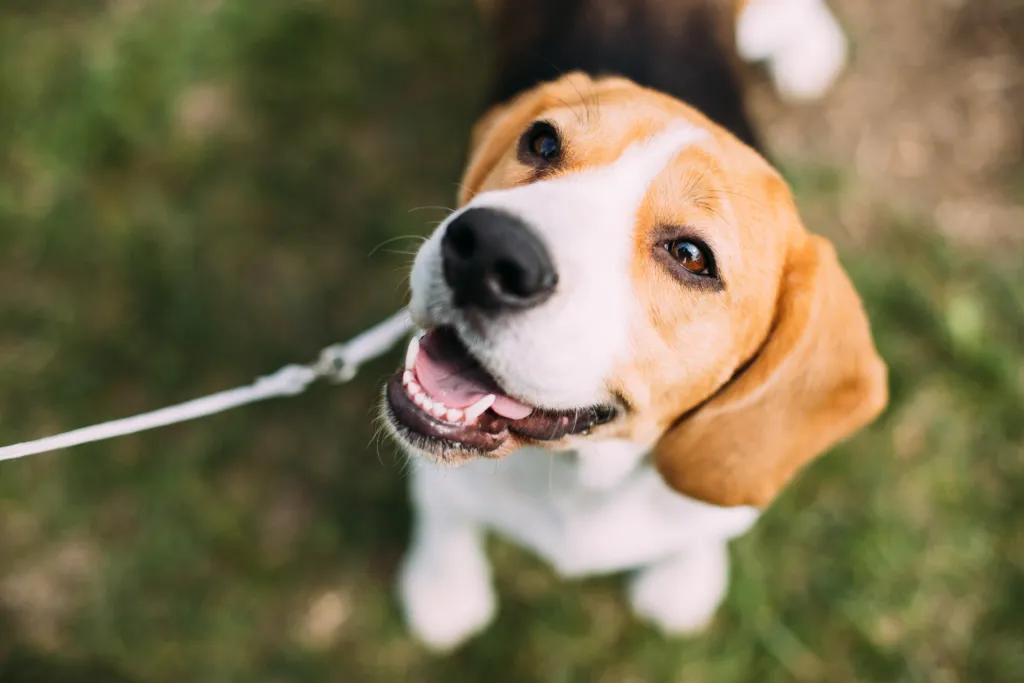 A hand offering a high-value treat to a happy dog, representing the positive reinforcement methods essential for teaching dogs how to walk nicely on a leash.
A hand offering a high-value treat to a happy dog, representing the positive reinforcement methods essential for teaching dogs how to walk nicely on a leash.
What You’ll Need:
- High-Value Treats: Small, soft, and easy for your dog to swallow quickly. Cheese, cooked chicken, hot dogs, or commercial training treats work well.
- Treat Pouch: Convenient for quick access to treats.
- A Standard 6-Foot Leash: Avoid retractable leashes.
- A Comfortable Harness or Flat Collar: While harnesses can offer better control without putting pressure on the neck, ensure it’s comfortable and fits well. Front-clip harnesses can be particularly helpful for dogs that pull.
Teaching Your Dog to Heel
Get yourself ready: Start with your dog on a leash, in a sit position on your left side. Hold a small supply of treats in your left hand and the leash in your right. Remember to deliver treats with your left hand to prevent your dog from cutting in front of you for a reward. The leash should always remain loose. Your dog will be learning to pace themselves, rather than you holding them in place.
Choose a phrase for movement: Decide on a consistent verbal cue you will use to signal that you are about to start moving. I typically use “Let’s go!”, but feel free to choose any phrase that suits you.
Get your dog’s attention: Ask your dog to “Focus” on you, and immediately reward them with a treat when they do. This ensures they are engaged before you start moving.
Begin: Say your chosen movement phrase (“Let’s go!”) and use your treat hand as a lure, holding it just in front of your dog’s nose to keep them right at your side. Take 3 steps with them in this perfect heel position, then reward them with a treat. Once you sense your dog is beginning to understand the game, start adding your “Heel” command as you initiate walking.
Practice: Dedicate ample time to practicing this! Gradually work up to being able to take 10 steps in a perfect heel. When your dog consistently performs 10 steps successfully a few times in a row, they are likely ready to move outdoors to your yard.
Every time you increase the distraction level, you need to take a step back in difficulty.
Move outside: Remember, your primary goal is for your dog to succeed! Since you’ve moved outside, revert to luring for 3 steps before offering a treat. As this becomes easy for your dog, slowly increase to 10 steps again.
Phase out the lure: Once your dog has mastered 10 steps in the yard, it’s time to stop constantly luring them with treats directly in front of their nose! Reward your dog for sitting politely beside you, then say “Let’s go!” followed by “Heel.” Slowly try to increase the number of steps you can take with your dog maintaining a perfect heel position. If you notice your dog losing focus, try talking to them in an encouraging tone to keep their attention. You want to reward your dog for checking in with you, so offer a treat every time they make eye contact voluntarily. Aim to keep your dog in a heel for a full minute between treats.
Practice! If your dog is accustomed to pulling you on the leash, you will likely need to spend several days practicing heeling in your yard. They are learning a brand new skill, and how to train a dog from pulling when walking requires repetition.
Remember to progress slowly! Behavior change is hard and takes time.
I suggest keeping training sessions short, around 20 minutes twice a day, to prevent both you and your dog from becoming overwhelmed or frustrated.
If your dog attempts to sniff or pulls sideways while heeling, say “Leave it” and apply the slightest amount of leash pressure (as you practiced in leash pressure training) to gently guide them back to your side. Reward them every time they return to your side. Remember, pulling no longer results in your dog getting what they want.
If they try to pull ahead of you, say “Let’s go!” and immediately turn to walk in the opposite direction. Reward them generously when they follow you! This teaches your dog that they need to stay by your side and pay attention. Teach your dog that you might change direction at any second, and amazing things happen when they follow.
I do not recommend adding in loose leash walking until your dog has consistently mastered one full minute of heeling in your yard. Learning two skills simultaneously requires more effort and mental capacity for your dog, so focus on one at a time for now. Take frequent sniff and play breaks between heeling sessions to keep the training fun and engaging.
Once your dog can easily heel for a minute in your yard, gradually advance the distraction levels of your walking environment. Start with a quiet street or path without other dogs (the new smells will be distracting enough). Remember: when you increase the level of distraction, always take a step back in other aspects of difficulty. I typically suggest returning to rewarding your dog for every 10 steps with each new walking environment. Your dog will likely learn faster and faster in each new setting, so increase the difficulty at their individual pace. Once your dog can heel for a minute in these new environments, you are ready to introduce loose leash walking instead of stationary sniff/play breaks.
Transitioning to Loose Leash Walking
Once your dog has learned the basic rules of heeling, it’s time to incorporate loose leash walking!
Again, I define loose leash walking as the dog being allowed to explore anywhere within the boundaries of their leash. If I cannot easily hold the leash with one finger, it does not count as loose leash walking. There should be absolutely no leash tension! If your dog wants to sniff during loose leash walking, stop and let them! I do not allow pulling, but otherwise, loose leash walking provides the freedom to simply be a dog. Walks should be enjoyable for your dog too.
How to teach your dog to loose leash walk:
Have your dog sit at your left side. Again, say “Let’s go!” to signal movement, then immediately follow it with “Ok!” and point in front of you. Your dog will likely hesitate a bit since they are accustomed to heeling. Keep walking and allow your dog to slowly move away from you. If they stop to sniff something, let them! If the sniff lasts too long, say their name followed by either “Let’s go” or “Leave it,” and reward them with a treat when they start walking with you again.
It is highly beneficial to practice transitioning smoothly between heeling and loose leash walking. While your dog is learning, make these transitions easier by having them sit between commands. “Let’s go” always signals that you want movement, then “Heel” or “Ok” communicates the boundaries of where they should walk. Consistency is incredibly important for dogs, so ensure you use your verbal cues properly and consistently. For further guidance, consider resources on [how to teach your dog to not pull](https://dogcarestory.com/how-to-teach-your-dog-to-not-pull/).
Your dog will be enticed by more smells and freedom during loose leash walking, so keep in mind that it can be a difficult skill to learn.
Troubleshooting Tips for Loose Leash Walking Success
Here are a few tips to help you navigate common challenges:
- Maintain a No-Pulling Policy: You must consistently enforce a strict no-pulling rule. Be vigilant not to accidentally reinforce pulling by letting your dog drag you to an interesting smell. Dogs earn their freedom on walks by maintaining polite leash manners.
- Encourage Check-ins: You want your dog to actively want to check in with you and be aware of your location. You should notice them looking up at you more frequently after practicing “Focus” and heeling. Keep reinforcing this! Give your dog a treat every time they make eye contact with you without being cued.
- Read Body Language: Observe your dog’s body language carefully during loose leash walking. Most dogs have a subtle “tell” just before they start to pull. You might notice their eyes lock onto something or their ears drop slightly. If you see these signs, immediately say “Let’s go!” and turn in the opposite direction before they even begin to pull. Reward your dog for following you in the new direction! The most effective time to correct pulling is before it happens.
- Manage Distractions: If an unexpected distraction arises during training, try to increase the distance between it and your dog. This could mean crossing the road if you see another dog or turning to walk in the opposite direction. If your dog seems overly distracted, ask them to sit and practice “Focus” (rewarding every successful focus). Sometimes, your dog simply needs a mental break!
- Persistent Temptations: If there’s a particular spot with an irresistible smell that your dog can’t help but pull towards, tell them to “Leave it” and use a treat to switch directions. Then, turn around and try walking past it again. If they still can’t resist pulling towards it, instead put them in a “Heel” and use a treat to lure them past the temptation. It’s okay to make mistakes, but never reward pulling by giving in.
- Gradual Increase: Slowly increase the duration and distraction levels of where your dog is loose leash walking. Remember to build the skill gradually! Always create opportunities to reward your dog for making the right choices. For more advanced troubleshooting, look into
[how to train a dog from pulling when walking](https://dogcarestory.com/how-to-train-a-dog-from-pulling-when-walking/).
Conclusion
Both you and your dog deserve to enjoy your walks together. While it can take time to undo established pulling behaviors, the effort is incredibly worthwhile. Just imagine: in as little as one month, you could be confidently walking your dog without any pulling, enjoying peaceful and stress-free outings! How amazing would that transform your daily routine?
Please share your successes in the comments below once you’ve achieved reliable loose leash walking with your dog! Happy training!
